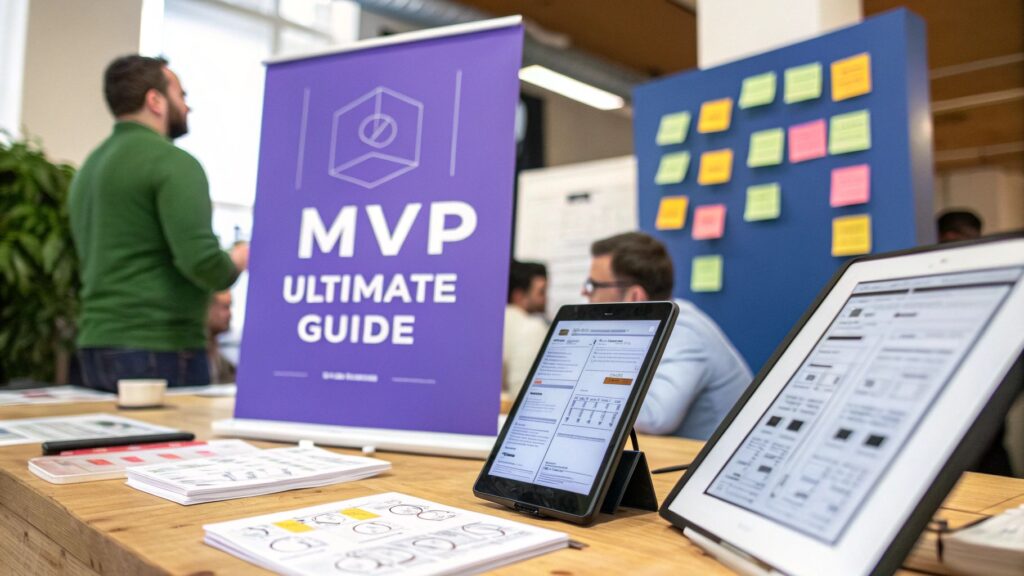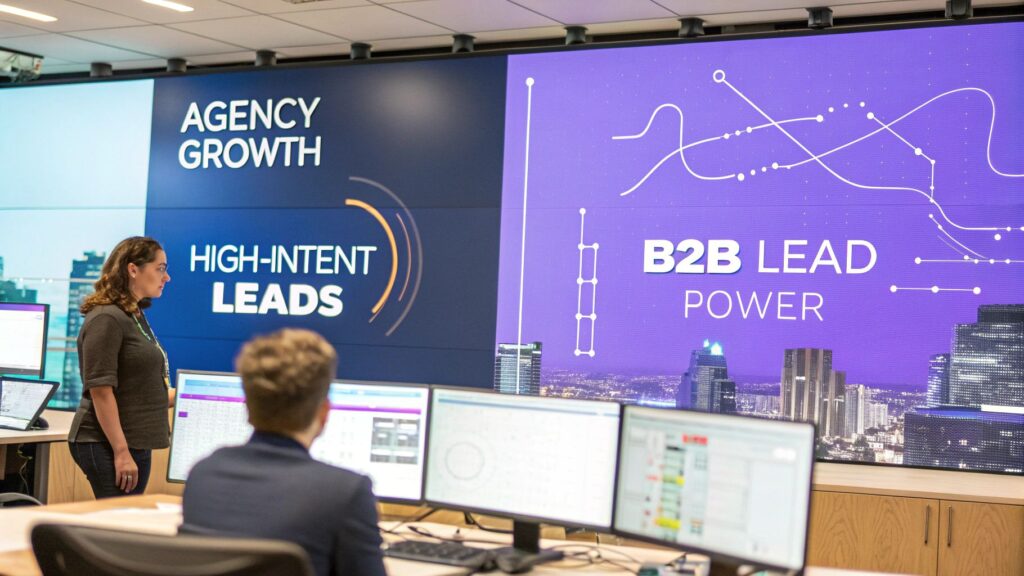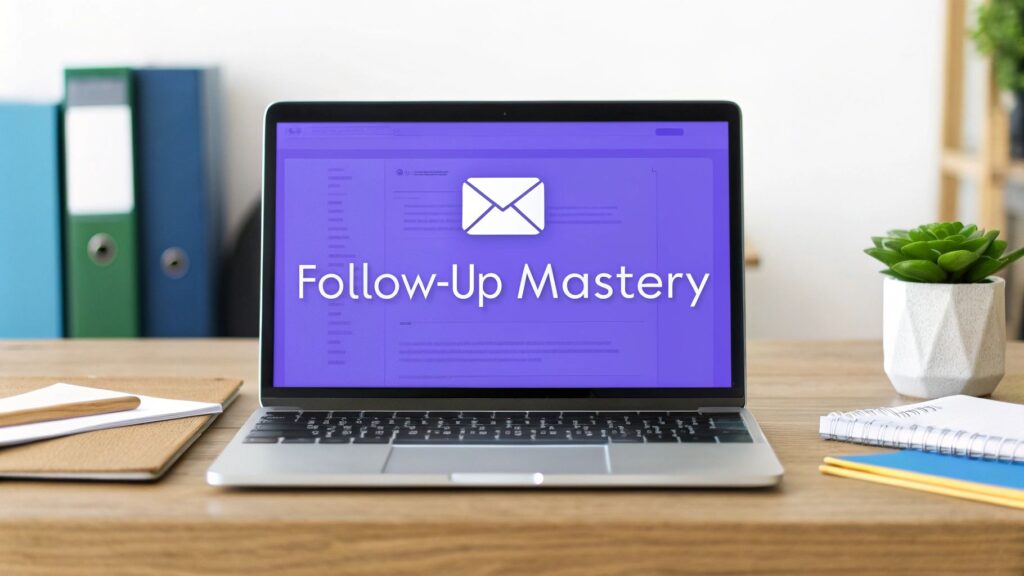What Is Minimum Viable Product Your Ultimate Guide

A Minimum Viable Product, or MVP, is the most basic version of a product you can launch. Its entire purpose is to solve one key problem for a small group of early users, using the absolute minimum in development time and money. According to a 2023 report by Startup Genome, premature scaling is a primary factor in 70% of startup failures—an MVP is the strategic antidote to this common pitfall.
What Is a Minimum Viable Product Really
It’s easy to think of an MVP as just a stripped-down product, but that misses the point. It’s actually a strategic experiment designed to test a core business hypothesis with real users.
Imagine you have a theory that freelance graphic designers need a better way to manage client projects and invoices. Instead of building a full-featured project management suite with team collaboration, time tracking, and advanced reporting (a project that could take a year and cost six figures), you build an MVP. This MVP might only do two things perfectly: allow a designer to create a simple project and generate an invoice for it. This is your core value proposition.
The whole approach is built around validated learning. You get a lean version into the hands of real customers to see what they actually do with it. Their actions and feedback give you hard data, confirming whether your idea has legs before you commit to building out the rest. It's about building just enough to start learning.
The Origins of the MVP
The term "Minimum Viable Product" was coined by Frank Robinson back in 2001, but it really took off when Eric Ries featured it in his famous 2011 book, The Lean Startup. The core idea is simple: launch a product with just enough features to attract early adopters and, more importantly, to collect feedback for what comes next.
This strategy is a direct response to a painful reality—many startups fail because they build something nobody wants. A CB Insights analysis of startup post-mortems found that "no market need" is a top reason for failure, cited by over 34% of failed startups. An MVP flips that script by focusing on core function over a long list of features, delivering real value to a specific audience right away.
An MVP isn't a buggy or incomplete product. It's a focused, polished solution to a single, critical problem that helps you learn what your customers truly want.
By starting small, you can measure how people engage, listen to what they have to say, and make decisions based on data, not just guesswork. This cycle of building, measuring, and learning ensures that every feature you add from that point on is something your users have already told you they need. It’s a smarter, more efficient way to build products people will actually use.
Why an MVP Is Your Smartest First Move
Let's be direct: launching an MVP is the single best way to protect your new product from failure. It confronts the number one startup killer head-on—building something that no one actually wants. Instead of burning through your budget to create a feature-packed product based on a hunch, an MVP gets your core idea in front of real users, fast.
This approach pays off immediately. By focusing only on the must-have features, you slash your initial development costs and get to market much quicker. Industry data from Standish Group shows that over 50% of software features in enterprise products are rarely or never used. An MVP helps you avoid building that costly, unused bloat from the start.
But the real magic of an MVP isn't just about saving time and money. It's about validated learning—the process of using actual user feedback, not guesswork, to decide what to build next.
The Feedback Loop Advantage
An MVP is your direct line to the people who matter most: your customers. It kicks off a powerful feedback loop that guides your entire development roadmap, ensuring every new feature you add is something people have already told you they need.
This user-first model delivers some serious benefits:
- Market Validation: You find out right away if you have a real audience willing to pay for what you're offering.
- Reduced Risk: It stops you from wasting money on features nobody will ever use. The numbers don't lie; you can dig into the common startup failure statistics yourself.
- Faster Iteration: Small, focused updates mean you can adapt and improve your product far more quickly than with a slow, traditional launch. A practical insight is that teams shipping smaller updates can deploy code up to 30 times more frequently than those working on large, monolithic releases.
An MVP turns your product launch from a massive, all-or-nothing gamble into a smart, strategic experiment. It's how you make sure you’re building a product people will actually use and pay for.
Shifting your focus from just "building a product" to "learning from your users" is what gives you a real competitive edge. It's a move that saves you time, money, and a whole lot of headaches.
The 3 Key Ingredients of a Successful MVP
A great MVP isn't just about stripping a product down to its bones; it's a strategic first step designed for one thing: learning. The whole idea hinges on getting three key ingredients just right—viability, feasibility, and desirability. Nail this balance, and you have a smart experiment. Get it wrong, and you're left with a useless, stripped-down product.
First up is viability. This is the hard-nosed business question: does this product actually solve a real problem that people would eventually pay for? A viable MVP has to target a genuine pain point for a very specific group of users. For example, an MVP is viable if it can demonstrate a potential for positive unit economics, even at a small scale. You're not just building something cool; you're testing a hypothesis that solving this particular problem can grow into a sustainable business.
Next, you need a reality check, and that’s where feasibility comes in. Can your team actually build the core of this thing with the time, money, and tech you have right now? This forces you to be ruthlessly practical. You have to focus on what’s truly achievable in the short term to get the product into users' hands. A huge part of this is deciding what features make the cut, and using effective prioritization frameworks like RICE and MoSCoW can be a lifesaver here.
Finding the Sweet Spot: User Desirability
The final, and arguably most important, piece of the puzzle is desirability. This is all about the user. Even a minimal product has to be usable and solve the core problem elegantly. Is the experience clean? Does it work so well that users are willing to forgive the missing bells and whistles? The goal is to make something that your first users—your early adopters—find so compelling that they'll not only use it but also give you the honest feedback you crave. This is impossible if you don't first know how to identify target customers who will find your solution desirable.
The image below really brings home how these three pillars work together to support the entire MVP strategy.
As you can see, a well-executed MVP, balanced across these three areas, is your fastest path to real-world feedback, lower development costs, and genuine market validation.
One of the biggest myths is that an MVP can be rough around the edges or buggy. The truth is, a strong MVP has to be polished enough to be desirable. It must solve the core problem without friction to prove it's viable.
When you think about it, what is a minimum viable product if not a careful balancing act? Without viability, you build a solution in search of a problem. Without feasibility, your great idea never leaves the whiteboard. And without desirability, no one will ever bother to use it, let alone tell you how to make it better.
Mvp Vs Prototype Vs Final Product
To truly grasp the concept of an MVP, it helps to see how it stacks up against a prototype and the final, full-featured product. They each serve a very different purpose at different stages of development.
| Attribute | Prototype | Minimum Viable Product (MVP) | Final Product |
|---|---|---|---|
| Primary Purpose | Validate a concept or design idea. Answer "Can we build this?" | Validate a business hypothesis. Answer "Should we build this?" | Deliver a complete, polished, and scalable solution to a broad market. |
| Audience | Internal team, stakeholders, or a small test group. | Early adopters and a specific target customer segment. | The general public or the entire target market. |
| Scope & Functionality | Limited to no functionality; often a visual mockup or wireframe. | Core functionality to solve one key problem effectively. | Comprehensive feature set, fully functional, and robust. |
| Goal | Gather feedback on usability and design. | Gather real-world user data and feedback to guide future development. | Capture market share, generate revenue, and retain users. |
| Example | A clickable wireframe of a new app created in Figma. | The first version of Instagram, which only allowed photo posting with filters. | The current version of Spotify with podcasts, personalized playlists, and social features. |
This table shows that while a prototype tests an idea and a final product delivers a complete experience, the MVP sits right in the middle. It’s a real, working product designed specifically to test your core business assumptions with the least amount of effort.
How Famous Companies Started with an MVP
It’s one thing to talk about the theory behind a minimum viable product, but seeing it in action is what really drives the point home. Some of the biggest brands you know today didn't burst onto the scene with a polished, feature-packed product. They started small, with a lean MVP built to answer one critical question.
These stories aren't just for scrappy startups. They prove that validating an idea before you bet the farm is a powerful strategy for anyone. They built just enough to get in the game, paid close attention to their first users, and slowly iterated their way to the top.
From a Video to Billions: Dropbox
Before sinking a fortune and countless hours into building his complex file-syncing technology, Dropbox founder Drew Houston had to answer a fundamental question: did anyone even want this? Writing the actual code would have been a massive undertaking.
So, his MVP wasn't a product at all. It was a simple 3-minute explainer video.
The video walked potential users through how the file-syncing would work, clearly demonstrating its core value. Houston then posted it on Hacker News, a popular tech forum, and waited to see what would happen.
The reaction was explosive. Almost overnight, his beta signup list ballooned from 5,000 to 75,000 people. That simple video was all the proof he needed. It confirmed his core assumption—people were desperate for a better way to sync files—and gave him the validation required to secure funding and build the real thing.
Zappos: The No-Inventory Experiment
Back in 1999, Nick Swinmurn had a wild idea: would people actually buy shoes online without being able to try them on first? The alternative—building a massive e-commerce platform and stocking a warehouse full of shoes—was a huge financial gamble.
His MVP was genius in its simplicity and cost next to nothing.
- The Test: He went to local shoe stores, took pictures of their inventory, and posted them on a bare-bones website.
- The Process: When a customer placed an order, Swinmurn would physically go back to that store, buy the shoes at full price, and ship them out himself.
- The Validation: He wasn't turning a profit—in fact, he was probably losing money on each sale. But profit wasn't the point. He was proving, with real transactions, that people were willing to buy shoes online.
This manual, "fake it 'til you make it" approach confirmed his business model was viable. It was the first step on a journey that led to Zappos becoming a $1.2 billion company that was later acquired by Amazon.
To see how other companies have put this concept into practice, it's worth checking out more real-world minimum viable product examples. These stories show just how powerful a clever MVP can be for answering your biggest business questions with the smallest amount of risk.
Your Step-by-Step Guide to Building an MVP
Jumping from a great idea to a tangible product can feel like a huge leap. But building a minimum viable product doesn't have to be chaotic; it follows a pretty clear, logical path. The goal isn't just to ship something fast. It's about building the right thing to learn as much as possible, as quickly as possible.
Everything starts with solid market research. You're looking for a genuine pain point, not a solution in search of a problem. Pinpoint a significant, underserved need that people are actively trying to solve. A practical tip is to search forums like Reddit or Quora for keywords related to your idea; if people are frequently asking for solutions or complaining about existing tools, you've likely found a real problem.
Once you’ve found the problem, you have to figure out who you're solving it for. Getting inside the head of your ideal customer is critical. For a deep dive on this, take a look at our guide on how to create buyer personas. This insight lets you map out the core user journey—the absolute essential steps someone takes to get from A to B with your product.
Prioritize and Define Your Core Features
With a user journey mapped out, you can start brainstorming features. But here’s the tricky part: you have to be ruthless. An MVP is defined more by what you leave out than what you put in.
A fantastic tool for this is the MoSCoW framework:
- Must-have: These are the non-negotiables. If you don't have these, your product is basically broken and doesn't solve the core problem.
- Should-have: Important features that add real value, but aren’t mission-critical for the very first version.
- Could-have: These are the "nice-to-haves." They're desirable, but can absolutely wait for a future update.
- Won't-have: Features you've explicitly decided are out of scope for now. This helps you avoid feature creep and stay focused.
Using this framework forces you to concentrate only on the Must-haves. It’s a disciplined way to keep your MVP lean and laser-focused on its primary value.
Build, Measure, and Learn
After you’ve got your priorities straight, it's time to build, launch, and kick off the feedback loop. This cycle, made famous by The Lean Startup, is the heart and soul of any good MVP strategy.
The purpose of an MVP is to start a learning process, not finish a product. The feedback you gather after launch is more valuable than the initial code you wrote.
Before you go live, decide what success actually looks like. Set clear, measurable metrics—user sign-ups, engagement rates (like Daily Active Users), conversion goals, or Net Promoter Score (NPS). For instance, a SaaS MVP might aim for a 5% conversion rate from free trial to paid subscription within the first month. These numbers give you the hard data you need to make sense of user feedback and make smart, informed decisions for the next version. It’s how you turn guesswork into a repeatable system for making your product better.
Common Questions About Building an MVP
Even with the best intentions, the MVP concept can feel a bit fuzzy in practice. A few common questions always pop up, and getting the answers right can mean the difference between a successful launchpad and a dead end.
Let's clear the air on some of the most frequent sticking points I see teams run into.
How "Minimal" is Minimal?
This is probably the biggest source of confusion. The "minimum" in MVP refers to the scope of features, not the quality of the experience. It’s not about building something cheap or half-baked.
Think of it as being surgically precise. Your MVP needs to be a real, functioning product that solves one core problem exceptionally well for a specific group of people. A great practical example is the first version of Buffer, which only allowed users to schedule tweets. It didn't have analytics, team features, or support for other social networks, but it did its one job perfectly, which was enough to validate demand.
Isn't This Just a Prototype?
Nope, they're two very different tools for two very different jobs. A prototype is a sketch, a mockup, or a wireframe—it’s a non-working model designed to explore how an idea might look and feel. You use it to get feedback on a design, usually internally.
An MVP, on the other hand, is a working piece of software released to the public. It’s out in the wild, collecting real data from real users.
Here’s a simple way to frame it: A prototype helps you answer, “Can we build this?” An MVP forces you to answer a much more critical question: “Should we build this?”
One validates a design concept; the other validates a business model.
When Do We Know the MVP is "Done"?
An MVP has done its job once it gives you a clear answer—yes or no—to your core hypothesis. Its entire purpose is to be a learning machine.
If the user data comes back positive and people are genuinely using your product, the MVP isn't "done." It's just become version 1.0, and now the real work of iterating based on feedback begins. A clear signal is when you achieve "product-market fit"—typically defined by the 40% rule, where over 40% of your users say they would be "very disappointed" if they could no longer use your product.
But what if the data shows nobody's interested? In that case, the MVP was an even bigger success. It just saved you a massive amount of time, money, and heartache you would have spent building something nobody wanted.
Ready to connect with startups that have just secured the funding to build their next big idea? FundedIQ delivers curated lists of high-intent prospects, giving your agency direct access to companies ready to invest in growth. Stop guessing and start engaging with decision-makers at the perfect moment. Find your next client with FundedIQ.





